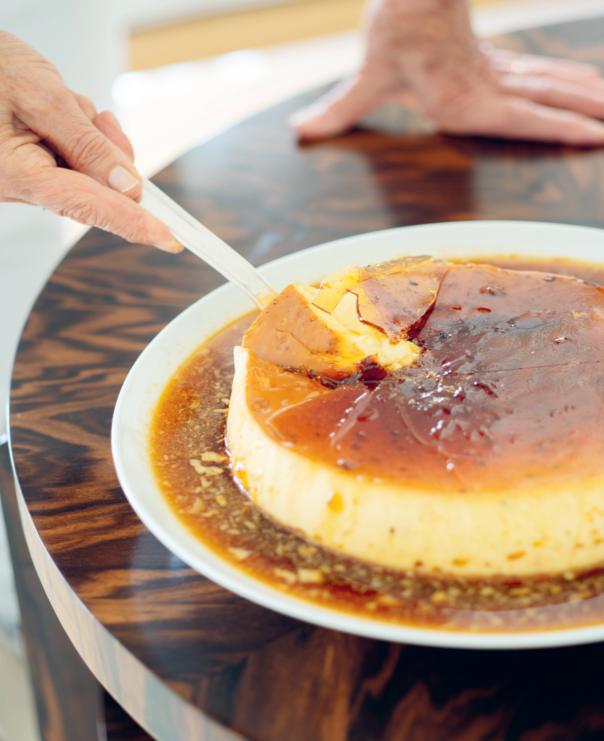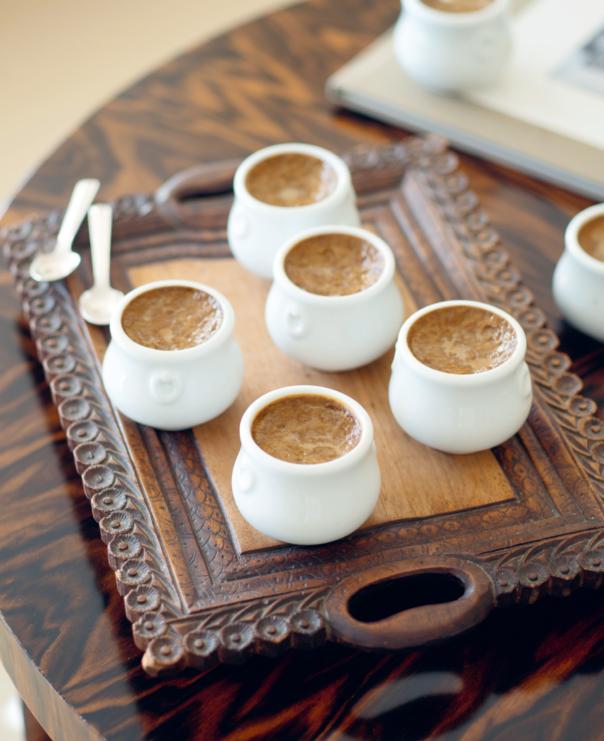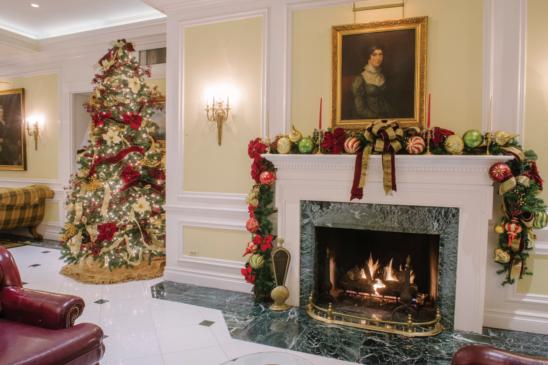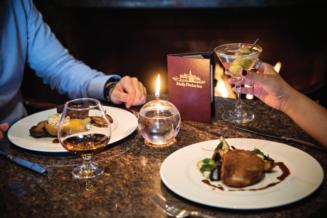
7 minute read
Save Room for Dessert
A feast isn’t a feast without something deliciously sweet to finish it off. These desserts will ‘wow’ a crowd and conclude a perfectly yummy meal.
PATRICIA’S CRÈME CARAMEL
Serves 8
FOR THE CARAMEL: n 3 Tbs. water n 1¼ cups sugar
FOR THE CUSTARD: n 4 cups whole milk n 1 Madagascan or Tahitian vanilla bean (or ½ tsp. ground vanilla bean) n 6 eggs n ¼ cup superfine sugar Preheat the oven to 350°F. Prepare the caramel by putting the water and sugar in a saucepan set over high heat. Swirl the pan occasionally until the sugar dissolves and then boil until the syrup turns a deep amber color. Pour immediately into a 9-inch porcelain soufflé dish and tilt the dish to coat the bottom and sides.
Immediately put the saucepan to soak in hot water—this will make it easier to clean. To prepare the custard, pour the milk into a saucepan. Split the vanilla bean lengthwise and scrape the seeds into the milk, adding the bean as well, or add the vanilla powder (if using). Bring to a boil, remove from the heat, cover and let infuse for several minutes before removing the bean.
Whisk the eggs in a mixing bowl. Slowly pour in the hot milk, stirring slowly but continuously with the whisk to avoid creating froth. If there is any, remove it with a skimmer. Pour the custard into the dish over the caramel and carefully lift it into a roasting pan. Pour in enough water to come halfway up the sides of the dish. Bake for 30 minutes, watching closely as the water should reach a gentle simmer without either the custard or the water coming to a boil. If this happens, lower the oven temperature to 325°F.
Carefully remove the roasting pan from the oven and lift the soufflé dish out of the pan. Let the crème caramel cool to room temperature, and then either turn it out into a serving dish or serve it directly from the soufflé dish. Dust with superfine sugar.

ARTHUR’S CHOCOLATE GATEAU
Serves 8
FOR THE CAKE: n 10 ½ oz. dark chocolate, 70 percent cacao n 3 Tbs. black coffee (or 1 tsp. instant coffee dissolved in 3 Tbs. boiling water) n 1¾ sticks salted butter, thinly sliced and softened n 5 eggs n 1 cup confectioners’ sugar, divided, plus extra for dredging
FOR THE CRÉME ANGLAISE: n 2 Madagascan or Tahitian vanilla beans (or a few coffee beans, for coffee crème anglaise) n 14 egg yolks n 1¼ cups sugar Remove a rack from the oven and preheat the oven to 300°F. Stand a 9½-inch nonstick shallow cake pan (preferably silicone) on the rack to make it easier to transfer to the oven when filled with cake batter. Chop the chocolate into small pieces and place in a microwave-safe bowl with the coffee and butter. Microwave on full power for 1 minute to melt the butter and partially melt the chocolate, making sure the mixture doesn’t boil. There will still be some half-melted pieces of chocolate, so work it with a spatula until they melt and the chocolate is perfectly smooth. Alternatively, you can melt the chocolate, coffee and butter together in a saucepan over low heat, stirring constantly with a spatula until smooth.
Separate the eggs, placing the yolks in one large bowl and the whites in another. Add ¾ cup of the confectioners’ sugar to the egg yolks and whisk with an electric beater until pale and foamy. Wash and dry the beaters, and then whip the whites with the remaining confectioners’ sugar until firm peaks form. Whisk the melted chocolate mixture into the egg yolks until smooth. Using a spatula, gradually fold in the whites until no streaks remain, taking care not to deflate them.
Pour the batter into the pan, slide the rack back into the oven and bake for 22–25 minutes until the cake is set but still soft in the center. If you have used a nonstick rather than a silicone pan, let the cake cool for 20 minutes before turning it out onto a serving plate. Let cool to room temperature. If you have used silicone, let the cake cool in the pan, and turn it out when ready to serve. The cake can be left at room temperature for several hours but do not refrigerate it. At the last minute, dust the cake with confectioners’ sugar and serve with Crème Anglaise.
To make the Crème Anglaise, put the milk in a large saucepan, slit the vanilla beans lengthwise and scrape the seeds into the milk, adding the beans as well (or add the coffee beans, if using). Bring to a boil, remove from the heat and cover. Let infuse for 15 minutes (15–30 minutes for the coffee beans) and then remove the beans.
Chill a large metal spoon in the refrigerator to test the custard. In a large bowl, whisk the egg yolks and sugar together until pale and thick. Slowly drizzle in the infused milk, whisking constantly. Pour it back into the saucepan and stir constantly with a wooden spatula (making figure eight movements is less tedious), over low heat for 15–20 minutes, until the custard thickens and coats the spatula. It is important not to let the custard boil or the egg yolks will scramble.
Remove it from the heat and stir for a few more minutes. Dip the chilled spoon into the custard to coat the back of it, draw a line down the center with your fingertip and if the line holds, the custard is ready. If not, cook for a few more minutes and test again but do this frequently as an undercooked custard will be too runny and an overcooked one will curdle. Pour into an attractive serving bowl or jug and press plastic wrap over the surface to prevent a skin forming. Let cool and chill for at least 2 hours.

LITTLE COFFEE CUSTARDS
Makes 12 5-oz. porcelain custard cups
n 3⅓cups whole milk n ¾ cup heavy cream n 4 Tbs. instant decaf coffee granules n 10 egg yolks n 1 cup sugar Heat the milk and cream in a saucepan over low heat and stir in the instant coffee until dissolved. Remove from the heat and let cool slightly.
Preheat the oven to 350°F. Line the base of a baking dish large enough to hold the 12 custard cups with aluminum foil. In a mixing bowl (preferably with a spout), whisk the egg yolks and sugar together until pale and thick. Gradually pour in the coffee-infused milk and cream, stirring gently with the whisk to avoid creating froth. Place the empty custard cups in the prepared baking dish and pour enough hot water into the dish to reach halfway up the sides of the cups. Slowly fill the custard cups to within ½ inch of the tops, trying not to create air bubbles as you do so. If there are any bubbles, burst them with the tip of a knife or remove them with a teaspoon, so the custards will be smooth and shiny on top when cooked. If you leave them, little craters will form on the surface, which isn’t very appetizing.
Cover the custard cups with a sheet of aluminum foil and cook for 40–45 minutes, checking occasionally to make sure the custards are not boiling. You’ll know they are ready when they are set but still have a slight wobble.
Remove the baking dish from the oven and, taking care not to burn yourself, lift out the custard cups and let cool to room temperature. Once the custards are no longer warm, you can chill them in the refrigerator. Serve chilled or at room temperature.
All photos and recipes are reprinted with permission from Enjoy: Recipes for Memorable Gatherings by Perla Servan-Schreiber. Photos by Nathalie Carnet. Flammarion 2020.
Where knowledge meets experience

Like many things of value, your financial picture is complex, with lots of moving parts. Whether you’re ready to buy a new home with a larger garage for your treasures, purchase a vacation getaway in your favorite secret spot, or refinance an existing home, I’m ready to help you reach your goals. Located and working in the Red Bank, surrounding Two River, and greater Monmouth area, I’m familiar with the local marketplace, amenities, and unique personality of the region. With 20 years in the home financing business, it would be my privilege to assist you at every stage of the homebuying process. As a Private Mortgage Banking customer, you’ll have access to a dedicated team ready to assist you, from consultation to closing and beyond. Together, we can bring your homeownership plans to life.
Mark Zacharczyk, Private Mortgage Banker 732-754-0056 | markz@wellsfargo.com www.loansbymarkz.com | NMLSR ID 142609






